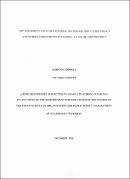| dc.description.abstract | This study examined the implementation of the USE policy on secondary school enrollments in Abim
District. Expressly. the study explored the influence of the implementation of LSE policy on
equitable access, completion, and dropout rates in three secondary schools of Lotuke seed
secondary. Abim secondary school and Molecule Girls Secondary School.
on probability sampling techniques was employed to obtain participants for the study. Both
qualitative and quantitative study design was used. A total of 59 key informants participated in
the study. The primary data was obtained using structured questionnaire and interview guides,
and secondary data through review of documentaries like school admission books, UCE
computer results (2006 and 2015 respectively), class registers, and statistical fo rms.
Quantitative data was analyzed using Statistical Package for Social Sciences (SPSS) version: 16
at two levels; first, descriptive summary of all the variables was generated using frequency
distribution; and secondly, the implementation of Universal Secondary Education on enrollments
was assessed using linear regression. Qualitative data was analyzed by identifying themes from
the finding of key informants· interview to respond to the objectives of the study.
The findings of this study indicated that the implementation of USE policy has resulted in
increase in enrollment of students in secondary schools in Abim District. However, the number of
boys enrolled still remains higher than that of girl s. Although the completion rates have
increased for both boys and girls following the introduction of USE policy, dropouts still remains
high especially among girls. Some of the major factors behind the increasing dropout of girls in the
District include; early marriages and pregnancies, low family income and peer influence. So the
study recommended the need to address cultural, school and structural barriers to secondary
school enrollments in Abim District. | en_US |

